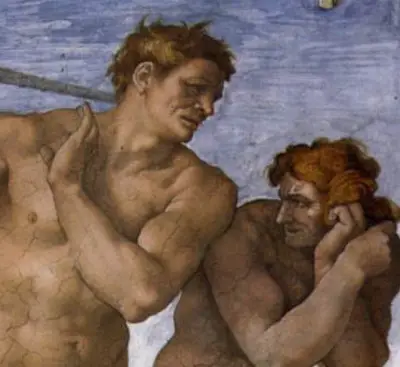This vault consists of nine scenes from Genesis beginning, at the south end, with The Separation of Light and Darkness and ending with The Drunkenness of Noah.
The Expulsion from Paradise is the second part of the sixth scene known as The Fall of Man and the Expulsion from Paradise.
The style of this painting was one initiated by Michelangelo near the beginning of the Renaissance period. He conceived art, unlike some of his contempories who felt compelled to follow classical ideals, as needing to convey a sense of human drama.
Unlike his predecessors, he uses, in this scene, intensely physical nude figures for Adam and Eve, the mastery of which shows his intense early study of anatomy. This style is particularly effective when he contrasts the smooth, young bodies of Adam and Eve at the point of Eve's temptation to their older and unattractive bodies when they are banished from Eden.
Michelangelo does not use more details than are necessary for the symbolism he wants to convey and so does not crowd the scene thereby giving clarity to his message.
Michelangelo united the Fall and the expulsion of Adam and Eve from the garden in the form of an uncial letter m (perhaps to signify his name)by using three pillars and two arches to unite them.
The central pillar consists of the Tree of Life wound round by a veiny serpent with a woman's head. To the left is another pillar made up of Adam and Eve in a mostly luxuriant setting (apart from rocks and a dead tree stump) with Eve holding the apple offered her by the female tempter in the tree.
The other branch of this tree extends into an airborne avenging angel with a sword that points to the expelled ugly, veiny, aged figures of Adam and Eve who make up the right hand column. This side of the scene is desolate.
Unlike Genesis 3:24 from which the story is taken the figures are nude and not covered in skins and there is only one cherub rather than the plural cherubim in the biblical account.
The whole scene is meant to be read from left to right showing the consequence of Eve eating the apple from the Tree of Knowledge leading to Adam and Eve's banishment from the garden of Eden. Michelangelo links this story to another biblical story. The dead stump represents the withered vine recalled in Joel's prophecy of the destruction of the fig tree and the vine.
According to Isaiah the vineyard of the beloved brought forth only wild grapes. God destroyed the vineyard's fence of stones as punishment. The stones, however, remain on the left-hand side of Michelangelo's scene as rocks.
The connection is made between Eve and the vineyard and has been reinforced by Michelangelo by giving her the same crouching pose as the woman crouching over the wine keg in The Deluge. This depiction of the Fall and expulsion from Paradise was a major influence in Masaccio's later painting The Expulsion from the Garden of Eden which added an evocation of Eve's howling.


